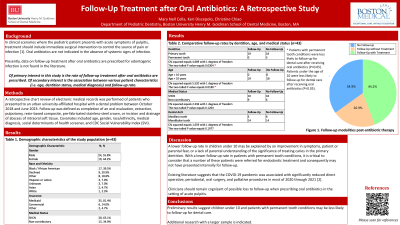Patient Management
271 - Follow-Up Treatment after Oral Antibiotics: A Retrospective Study

.jpg)
Mary Nelligan Cella, DDS, MS
Resident
Boston University, Boston, MA
Boston University
Boston, Massachusetts, United States- CC
Christine Chiao, DMD, MPH
Boston University
- KD
Keri Discepolo, DDS, MPH
Post Graduate Program Director of Pediatric Dentistry
Boston University Henry M. Goldman School of Dental Medicine
Boston, Massachusetts, United States - KD
Keri Discepolo, DDS, MPH
Post Graduate Program Director of Pediatric Dentistry
Boston University Henry M. Goldman School of Dental Medicine
Boston, Massachusetts, United States
Presenting Author(s)
Co-Author(s)
Co-Author(s)
Program Director(s)
Title: Follow-Up Treatment after Oral Antibiotics: A Retrospective Study
Purpose: In clinical scenarios where the pediatric patient presents with symptoms of acute pulpitis, dental treatment should be rendered promptly. This study aims to determine whether pediatric patients who present with a dental problem and receive oral antibiotics return for follow-up treatment. Of primary interest in this investigation is the rate of follow-up treatment after oral antibiotics are prescribed. Of secondary interest is the association between different patient characteristics (i.e. age, dentition status, medical diagnosis) and follow-up rate.
Methods: A retrospective chart review of electronic medical records was performed of patients who presented to an urban university-affiliated hospital with a dental problem. Follow-up constituted as completion of an oral evaluation, extraction, pulpotomy, resin-based composite, pre-fabricated stainless steel crown, or incision and drainage of abscess of intraoral soft tissue. Covariates included age, gender, race/ethnicity, medical diagnosis, social determinants of health screener, and CDC Social Vulnerability Index (SVI).
Results: In the study population (n=43), 67% of participants presented for follow-up after an antibiotic was prescribed for dental infection. Of those who had a follow-up appointment, 44% received definitive treatment within 3 months. Patients with permanent tooth conditions were significantly less likely to follow-up than those with primary tooth conditions (P < 0.05).
Conclusions: Patients in the permanent dentition may be less likely to follow up for dental treatment. Additional research with a larger sample is indicated.
Identify Supporting Agency and Grant Number:

.jpg)